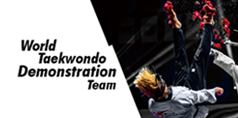
MOSCOW, Russia (21 June, 2014) - Anyone doubting the transformative potential of para-taekwondo should speak to Irma Cordoba.
“When you work with love, perseverance and interest, taekwondo accomplishes great things,” said the Colombian mother, speaking in a t-shirt emblazoned with the name of her daughter, Jhormary. “Though taekwondo, Jhormary has changed in unimaginable ways - including aspects of her life that medical therapies had not been able to overcome. “
Cordoba was speaking on the sidelines of the 5th World Para-taekwondo Championships, just after her daughter, Jhormary Rojas, 32, had delivered an impressive performance in poomsae competition– a sub-category of taekwondo added to the championships for the first time in Moscow for those with intellectual disabilities.
If kyorugi (sparring) is the “martial” side of taekwondo, poomsae is the “art.” Athletes are required to perform a series of pre-choreographed, solo, set movements – “poomsae” - against an imagined opponent.
The moves range from the simple – a chest-level punch – to the challenging – a head-level side kick. Poomse are graded to various levels of difficulty and in competition, athletes are graded on components such as movement correctness, precision and grace. While poomsae lacks the impact of kyorugi, it promotes concentration, balance, agility, flexibility and leg strength.
“Poomsae is meditation in action,” said Sergey Proskurnev, the chairman of Russia’s Poomsae Referee Committee. “It is really good, both mentally and physically.”
Poomsae is a demanding discipline even for those with normal memories and motor coordination.
Imagine, then, how much more challenging it is for the intellectually disabled – the category Jhormary was competing in. Add in impassive judges, a huge hall, fierce fighting underway on the adjacent matt and a noisy crowd - and the stress factors ramp up.
This did not stop four intellectually impaired athletes from competing in the event.
On the 21st, they marched to the completion mat, bowed in, performed their poomsae, bowed out and marched off. Their results appeared on electronic scoreboards.
Columbia’s Rojas was the only competitor to display two different poomsae; she also chose the most advanced patterns seen in the competition, Taebaek and Shipjin. Her performances were authoritative, displaying long, low stances and a clear expression of power that shook her dobok (uniform). Watching Rojas’ performance, one would be hard pressed to tell that she was in any way disabled. She ended with an overall score of 7.265.
Austrian Dominick Radosztics, 20, performed Taeguk 1-jang, taekwondo’s most basic poomsae. The nine-year taekwondo veteran gave a performance that showcased careful, deliberate concentration and finished with a sharp "kihap" (spirit shout). He repeated the form a second time, ending with a combined score of 5.400.
Russia’s Sergey Kiselov, 23, performed Kumgang Palchang. The poomsae is characterized by stance shifts, straight palm strikes and balance-challenging one-legged stances. Even though Kiselov clearly had difficulties remembering the movements – his coach gave verbal instructions from the sidelines – his athleticism and balance were impressive. He scored 4.735.
The fourth para-athlete registered for the poomsae event, Russian Nina Torgoshova, 19, was unable to compete at the event.
Although the main draw at the championships was clearly kyorugi, the poomsae athletes pronounced themselves well satisfied with their event.
“I was very happy to be able to do the best I could,” said Rojas. “I chose those poomsae as they are the ones that give me the most satisfaction - they are my passion!”
“I was not nervous at all, I enjoyed it,” said Radosztics, who was accompanied by his mother and his sister. “Also, it was my first time to fly, so I enjoyed the travel.”
“It was alright, we made it, we did what we could,” said Kiselov - who has less than a year’s taekwondo training under his belt. “I forgot a little bit, but … I’ll continue!’
Officials and coaches were equally pleased.
“I am very satisfied with the athletes, it was their first time, it is a good beginning,” said Proskurnev. “Their friends have seen them doing this, and they want to do it, too.”
Roja’s coach, Jesus Zuluega, said he has seen a lot of progress in his charge’s taekwondo, but that should not be surprising. “She has a lot of strength, discipline and perseverance and passion,” he said. “She perspires taekwondo!”
Still, the most emotional person in the arena was not a competitor, a coach or an official - but one very proud mother.
Embracing her daughter after the event, Cordoba said, “I am at a loss for words when I think of all the great things that taekwondo has done for my daughter. As a mother, I would like to share it with those in a similar situation.”


































